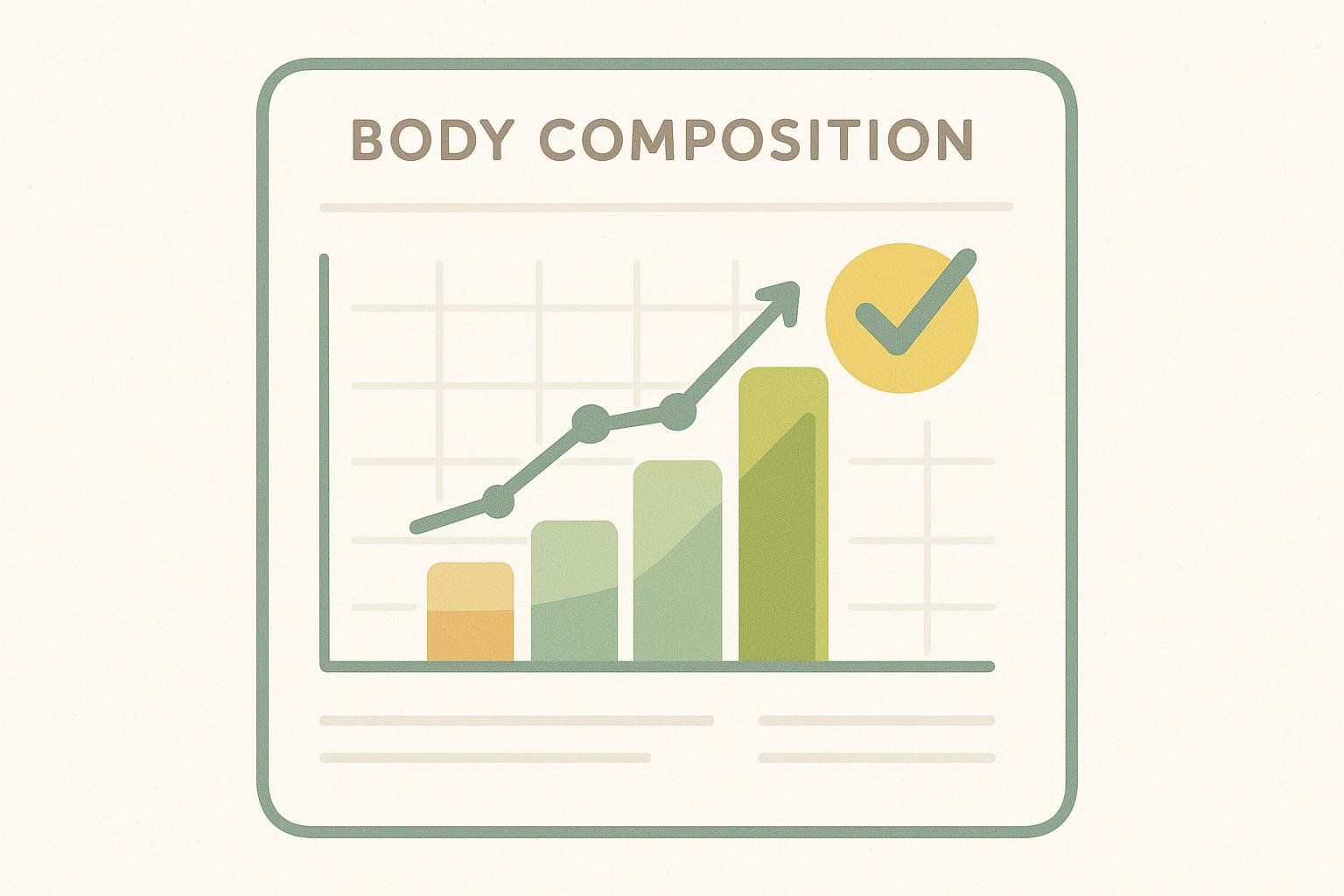How Fast Can You Gain Muscle?

How Fast Can You Gain Muscle? Realistic Timelines, Factors, and Tracking Tips
Ever wondered how fast you can get muscular after committing to the gym and dialing in your nutrition? Health authorities like the Cleveland Clinic note that beginners often add about 1–2 lbs of muscle per month when everything is dialed in. Research-based prediction models, however, show an even wider spectrum—roughly 0.25–3 lbs per month—depending on experience level, age, sex, and recovery habits.
Below, we break down realistic timelines by experience level, age, and sex—plus science-backed strategies to keep those gains coming.

Muscle-Gain Speed At-a-Glance
| Experience Level | Expected Monthly Lean-Muscle Gain | Rough Time to Gain 1 lb | What to Expect |
|---|---|---|---|
| Beginner (0–3 mo) | 1–3 lbs | ~2–4 weeks | Rapid strength jumps and visible fullness from “newbie gains.” |
| Intermediate (4–12 mo) | 0.5–1.5 lbs | 3–8 weeks | Progress slows; requires consistent progressive overload. |
| Advanced (>12 mo) | ≤0.5 lb | 8+ weeks | Minimal gains; needs highly specific, periodized programming. |
| Older Beginner (50+) | ≈0.25–0.75 lb | ~6–17 weeks | Joint-friendly exercises and extra recovery time are key (Peterson et al., 2011). |
Rates for beginners through advanced lifters come from the Aragon & Helms muscle-gain model and Lyle McDonald’s natural muscle-gain estimates, while the older-beginner row draws on a meta-analysis of resistance-training studies in adults 50+ Peterson et al., 2011.

These numbers assume you train each major muscle group at least twice weekly, consume adequate protein, and sleep 7–9 hours nightly. Deviating from these pillars can significantly slow progress.
Why Muscle-Gain Speed Isn’t One-Size-Fits-All
- Training Age & Neural Adaptation – New lifters gain strength quickly from improved nerve–muscle coordination before true hypertrophy kicks in; the ACSM notes sizable early strength gains driven primarily by neural factors (ACSM Position Stand).
- Genetics & Hormones – Genes such as myostatin and individual testosterone levels set an upper ceiling, but smart programming helps you maximize potential.
- Sex Differences – A systematic review shows men enjoy slightly larger absolute gains, yet women achieve comparable percentage increases when training volume and diet are matched (PeerJ, 2024).
- Age – Adults lose 3–8 % of muscle per decade after age 30 if inactive (Harvard Health). Training can slow or even reverse that loss.
- Lifestyle & Recovery – Sleep debt, high stress, or excessive cardio can blunt anabolic hormones and sap lifting energy.

Phase 1: Newbie Gains (Months 0–3)
What to Expect
Based on models like Aragon & Helms, beginners can gain 1–3 lbs of lean mass each month. Simultaneously, achieving body recomposition—gaining muscle while losing fat—is often most feasible during this novice phase (Cleveland Clinic).
Training Priorities
- Full-body workouts 3× per week or an upper/lower split 4× per week.
- 3 sets of 8–12 reps at 65–75 % of your estimated one-rep max.
- Master compound lifts: squats, deadlifts, presses, rows, pull-ups.

Nutrition Checklist
- Protein: 0.7–1 g per lb body weight (1.6–2.2 g/kg).
- Calorie surplus: ~250 kcal/day above maintenance to fuel growth without excess fat.
How to Measure Progress
Schedule a baseline BodySpec DEXA scan, then a follow-up at the 3-month mark to quantify those newbie gains. BodySpec DEXA scans measure lean-mass changes with ± 1% accuracy.
Phase 2: The Intermediate Grind (Months 4–12)
What to Expect
Growth slows to 0.5–1.5 lbs per month. Visible changes require intentional programming tweaks and meticulous nutrition.
Training Priorities
- Alternate 4-week hypertrophy blocks (8–12 reps) with strength blocks (4–6 reps).
- Push volume gradually—aim for 10–20 “hard” sets per muscle group weekly.
- Track progressive overload or add advanced techniques (drop sets, rest-pause).
Nutrition Checklist
- Keep protein high; bump your surplus to 300–400 kcal if progress stalls.
- Time carbs around workouts to sustain intensity.
Special Considerations for 50 + Lifters
- Allow 48–72 hours between hard sessions for the same muscle group.
- Emphasize joint-friendly variations (trap-bar deadlifts, floor presses).
- Include mobility drills and light cardio for circulation.
- Periodic DEXA scans can provide objective insight into muscle trends and potential sarcopenia risk.

Dialing In Your Nutrition
| Macro | Daily Target | Why It Matters |
|---|---|---|
| Protein | 0.7–1 g/lb | Provides amino acids for repair (ISSN Position Stand 2017) |
| Carbs | 2–3 g/lb (training days) | Refuels glycogen, powers lifts (ISSN 2017) |
| Fats | 0.3–0.4 g/lb | Supports hormone production (ISSN 2017) |
Hydration plus micronutrients like vitamin D and magnesium also play an important role in muscle-protein synthesis.

Need ideas for easy options? Check out our 25 high-protein snacks.
Training Variables That Make or Break Gains
- Volume – Hard sets per week.
- Intensity – Load relative to your one-rep max.
- Frequency – Hitting each muscle ≥ 2× weekly beats “bro splits” (ACSM).
- Rest – 60–120 seconds keeps hormonal responses favorable.
- Progressive Overload – Gradual weekly increases in reps, load, or density.
For deeper strategy, see our hypertrophy blueprint.
Recovery: The Unsung Hero
- Sleep: 7–9 hours supports muscle recovery, immune health, and hormone balance (Sleep Foundation).
- Active Recovery: Walking, yoga, or swimming speeds nutrient delivery.
- Stress Management: High cortisol competes with anabolic hormones—try breathwork or meditation.
- Deload Weeks: Cut volume 40–50 % every 6–8 weeks to let connective tissue heal.

Tracking Muscle Growth Accurately
| Method | Lean-Mass Precision | Typical Error |
|---|---|---|
| Bathroom scale | Low (cannot separate fat vs. muscle) | — |
| Tape measure | Moderate (user-dependent) | ± 1–2 cm |
| Smart BIA scale | Moderate (hydration-sensitive) | ± 3–5 % |
| DEXA (BodySpec) | High (gold standard) | ± 1–2 % |

FAQs About Muscle Gain Speed
How quickly can you get muscular?
Beginners on point with training, diet, and sleep often add 4–9 lbs of lean mass in 12 weeks. First visual changes show up around week 4–6; others notice by week 8–12.
How long does it take to gain 1 lb of muscle?
At beginner rates (1–3 lbs/month), 1 lb can accrue in 2–4 weeks. Intermediates may need 3–8 weeks, while advanced lifters might chase that single pound for two months.
Can I gain 5 lbs of muscle in a month?
Unlikely. Even perfectly executed newbie programs rarely exceed ~3 lbs/month. Claims of 5 lbs often include glycogen, water, or fat.
How long does it take to see noticeable muscle growth?
Subtle changes—tighter sleeves, more defined shoulders—appear by 4–6 weeks. Friends and family tend to comment after 8–12 weeks of solid consistency.
Building muscle is a marathon, not a sprint. Beginners see wins quickly; veterans chip away ounce by ounce. Control your variables—training, nutrition, recovery—and verify progress with BodySpec’s DEXA scans. Few things are as motivating as hard numbers confirming your hard work.


